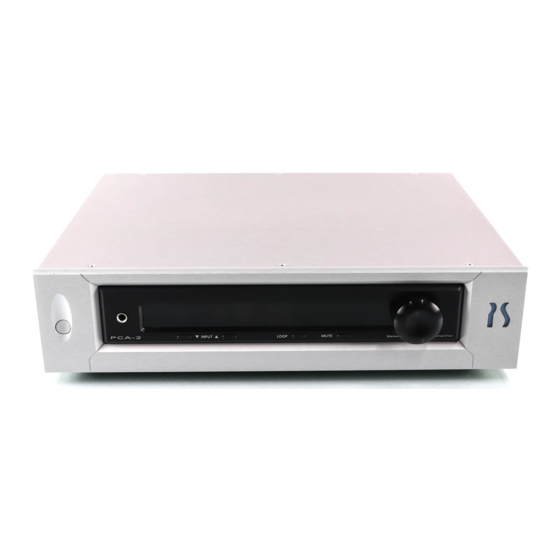Table of Contents
Advertisement
Quick Links
Table of Contents
1....What's in the Box
15..Warranty and Service Issues
16..Contact Information
What's in the Box
• One PCA-2 Preamplifier
• One IR remote control
• Two AAA batteries
• One 6 foot AC power cable
• One user's manual
• One warranty card
• One spare 3 amp fast blow fuse
IMPORTANT:
Be sure to save all packing materials included
with the PCA-2 Preamplifier as this will be
required if you ever need to ship the unit for ser-
vice or modification.
Advertisement
Table of Contents

Summary of Contents for PS Audio PCA-2
-
Page 1: Table Of Contents
• One warranty card • One spare 3 amp fast blow fuse IMPORTANT: Be sure to save all packing materials included with the PCA-2 Preamplifier as this will be required if you ever need to ship the unit for ser- vice or modification. -
Page 2: Overview
Overview The PCA-2 is a reference level stereo preampli- fier that can integrate into any type of audio or home theater system. The PCA-2 Preamplifier is designed to accom- modate input switching and volume control to a number of external source components while providing a signal as faithful and musically satis- fying as technologically possible today. -
Page 3: Quick Start Guide
Quick Start Guide Place the PCA-2 in a rack or on a shelf in the audio/video system. Turn off all associated components Connect the left and right analog audio out- puts from all audio/video source equipment to any of the inputs labeled 1-7 on the back of the PCA-2. -
Page 4: Rear Panel Layout
Rear Panel Layout 1. PS Bus and 12 Volt Triggers The PCA-2 comes equipped with a built in PS Bus. The PS Bus allows other PS Audio prod- ucts equipped with a PS Bus to communicate via standard RJ11 phone cable. -
Page 5: Front Panel Controls
Pressing the Power Button again will put the PCA-2 in a standby mode. It will consume very little power and not pass any signal to the ampli- fier. The display and the logo will not illuminate. -
Page 6: Ir Remote Control
2. Mute Pressing the Mute button will silence the output of the PCA-2. If Mute is activated the number of the present input will still be displayed but the display will read MUTE. To exit the mute status, press mute again or adjust the volume control. -
Page 7: Setup Menu
Input 8 is reserved for use with future expansion cards and is otherwise inactive. While the PCA-2 is in standby pressing any input button or the HT button will power on the unit and select the chosen input 8. - Page 8 To exit the setup menu at any time, press the power button on the front panel and all changes will be saved and the PCA-2 will go into standby. The settings in the Setup Menu are non-volatile. Even if the PCA-2 is disconnected from its power source, all Setup Menu entries will be stored.
- Page 9 PCA-2 when it is powered on. This is a useful protection feature to ensure that the PCA-2 is never set to too high a volume level for immediate playback, thus preventing damage to the connected speak- ers or amplifier.
-
Page 10: Using The Home Theater Bypass
To use the Loop function, connect the associated equipment to Input 7. Then connect the Loop Out on the back of the PCA-2 to the input or "monitor in" on the associated equipment. To use the connected device in loop mode, select the desired input and then press the loop button on the remote or front panel. -
Page 11: Using The Ps Bus
PCA-2 when con- nected. Use a 3.5 mm mini jack cable to connect the device to the PCA-2. While the PS Bus and the 12 Volt triggers can be used simultaneously they should not both be used with the same piece of equipment. -
Page 12: Troubleshooting Guide
Trouble Shooting Guide The PCA-2 was designed to provide many years or reliable, trouble-free operation. In the event the PCA-2 is not working correctly, please refer to the following suggestions: Unit will not turn on 1. Check the obvious. Is it plugged in and is the... - Page 13 Exit the setup mode by pressing the power button. One input plays too loud or too quiet The PCA-2 allows the user to adjust the gain of each individual input. Follow these steps to check this setting and make any necessary adjustments.
- Page 14 1. Check the batteries. Insert fresh, new batteries in the remote control and try operating the PCA-2 again. 2. The Setup Menu in the PCA-2 offers the abil- ity to adjust the remote code that the preamp will operate with. This is not a function the user should need to change.
-
Page 15: Appendix
D E F G H I J K L M N O P Q R S T U V W X Y Z <- - -> + Warranty inside the U.S. and Canada PS Audio’s warranty is 3 years parts and labor, from the date of original purchase, and is fully transfer- able. This means that we warranty the product itself regardless of ownership, new or used. - Page 16 PS Audio International, Inc. 4824 Sterling Dr. Boulder, CO 80301 USA Toll Free: 877-772-8340 Ph: 720-406-8946 Fax: 720-406-8967 www.psaudio.com...















Need help?
Do you have a question about the PCA-2 and is the answer not in the manual?
Questions and answers